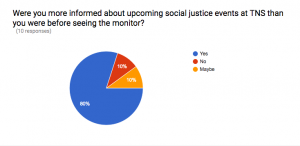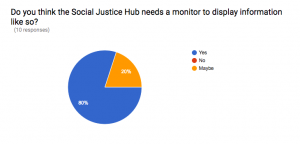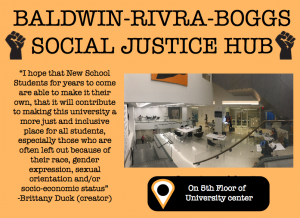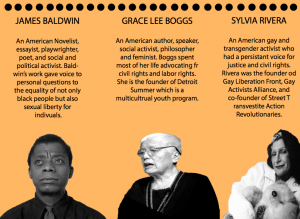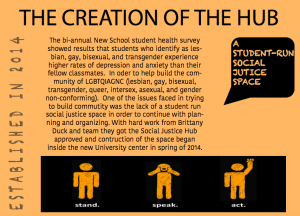Monthly Archives: March 2017
Social Justice in class Q’s
- My proposal is productive and somewhat empowering. It’s productive in the sense that it does it’s job in informing the intended audience. It empowers students to consider going to the to more social justice events and to get involved. The scale of the impact of my proposal is smaller but I think it’s necessary to the hub and the students who are uninformed. I thought of the proposal because I have social anxiety and it’s easier to get information if it’s right in front of me rather than putting myself out there and asking around. Also, being the daughter of immigrant parents I know how important it is for there to be events posted for people that are marginalized in any way.
- The audience I intended on targeting were students who aren’t very involved with the social justice hub but would like to learn more. I wanted to empower students in the hub doing homework or students that are walking by. A monitor is such an easy way to catching someone’s attention and informing them easily. My proposal targets students in the Social Justice Hub as a whole rather than few.
- I created my monitor prototype on illustrator and tried to incorporate things I learned in making an infographic into each slide. I kept simple colors using orange white and black and tried to utilize the whole screen without making it overwhelming to look at in the short period of time.
- How I would document this process would be through a survey. First I would show a random student in the hub my monitor (on my laptop) then I would let them answer an anonymous three question survey on google forms in order to receive their genuine answers.
Social Justice Hub engagement
For the Baldwin-Rivera-Boggs Social Justice Hub system I created, I wanted to make something that was both practical and effective. I created slides that would be screened on the monitor that’s located in the Social Justice Hub.
On the monitor would show a screen that says ‘Welcome to the Baldwin- Rivera- Boggs Social Justice Hub!’ along with pictures of James Baldwin, Sylvia Rivera, and Grace Lee Boggs. This slide does it’s job in telling people that don’t already know that the section of the 5th floor they are in is part of the Social Justice Hub. The next slide is a schedule mapped out of what clubs are booked on which day for each of the two meeting rooms in the Hub. This informs people of what kind of clubs are being held there and the day and times incase they want to go and attend them. The last slide is social justice events that are held in and outside of The New School. People can see the monitor and get involved with events and speeches for whenever they want.
A problem I encountered while figuring out the logistics of my system, was a system to display the screens on the monitor. I found a website system called Dashman that you can project any screen you want on any monitor for any period of time you want. This system should make it easy to update and keep track of what is displaying on the monitor for everyone to see.
For the engagement process, I showed 10 random people in the social justice hub my slides and gave them a survey of two questions. First question was “Do you know more about the social justice hub more than you did before viewing this monitor?” 80% said yes they know more after viewing the screen. The second question was “Do you think the Social Justice Hub needs a monitor?” and 80% said yes while 20% said maybe. Overall, everyone in the Hub agreed that it would be a good idea for the hub and that it couldn’t hurt to have something to have easy accessible information.
DESIGN JUSTICE PRINCIPLES
We prioritize a design’s impact on a community over the intentions of the designer.
- I tried keeping my design to directly impact those use the SJH but I always decided that it was also important to inform those who don’t know what the Hub is for because before this assignment I hadn’t known.
The strongest solutions happen through the process, not in a moment at the end of the process. Thus it is important to us to open up the design process to those who will be most impacted by its outcomes.
- Yes, I hadn’t known about problems until I was actually submerged into the assignment. Gail, who runs the SJH gave me insight to what the issues could be with my system, which was having a program that was easy to update the monitor when needed. I wouldn’t of thought about this aspect of the system until she mentioned it from the Hub organizer point of view.
We use design to dismantle structures that marginalize, dehumanize, subjugate, and oppress others while centralizing voices that are most marginalized by institutional racism, patriarchy, and colonization.
- I feel as though my system doesn’t give voice to those who are most marginalized because it is a system that is meant to give information. But on the other hand I could also see how it could empower some students who feel marginalized because it gives them information easily about events or clubs that they could get involved with.
We are reimagining the role of a designer as that of a creative facilitator rather than a creative expert.
- My system isn’t as creative as another system is, it’s more simple and practical with a certain purpose that it fulfills.
We are not just creating new solutions — we are looking for ways to adapt what is already working in other contexts as well as reviving ancient approaches that have been erased by colonialism and capitalism.
- My system takes information that is already there and surfaces it so everyone and gain more knowledge. It’s not a new idea to create a monitor but it’s an effective one.
We use design processes not just to address problems linked to various forms of injustice, but to build community, to heal, to experience joy, and to bring our visions of the future to life.
- My system doesn’t really fulfill this principle because it doesn’t necessarily bring joy to anyone although it could. My intentions were for it to build more community because it would get the Hub known and more people would show and everyone would know where and what the social justice hub is for however for a system like mine it’s hard to build the whole community rather than contribute to it.
We are finding low-resource, non-extractive solutions that enhance our connection to the earth.
- My system doesn’t really feel close to earth because it has to do with technology, however I think because the Hub already has a monitor that works, it doesn’t need a lot of resources to achieve this system.
Social Justice Hub Prototype
I created a prototype of a monitor that played slides of what is going on in the hub, what social justice events the school is holding, and potentially other things like quotes from those who the hub is named after (James Baldwin, Sylvia Rivera, and Grace Lee Boggs. The intended audience would be anyone who is in the hub whether they know the details of the hub or not, and students walking by. Students who are in the hub are usually working on projects or socializing and the monitor will be something that plays non stop so even if you catch a glimpse of it then it’s doing it’s job.
For a test run I would have to either rent out a monitor or use one that’s there to play the slide-show. Anyone walking by or looking around will be able to see and read what the monitor has on. Although it’s hard to see if people actually get use out of this system so I thought about the idea of some sort of feedback system to tell us whether they enjoy the monitor or whether it’s useless.

